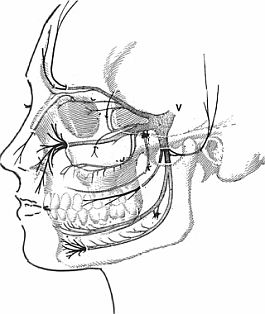 Nervus maxillaris: segunda rama del trigémino que nace del ganglio de Gasser. Abandona el cráneo por el agujero redondo mayor y llega a la fosa pterigo-maxilar donde se divide en varias ramas. La rama más importante es el nervio infrarobitario que penetra en la base de la órbita por el agujero suborbitario, pasando por el canal suborbitario y alcanzando el maxilar superior en su rama ascendente, por delante de la carilla articular del malar. Al salir del agujero suborbitario da ramas que se distribuyen por la mejilla. En su recorrido por el conducto orbitario da las ramas dentarias superiores y anteriores, que van a inervar los dientes de la parte más anterior del maxilar superior. Antes de entrar en el conducto suborbitario da otras ramas dentarias superiores y posteriores que van a inervar los dientes de la parte más posterior del maxilar superior. Hay otra rama antes del recorrido intraóseo que es el nervio cigomático que va a anastomosarse con el nervio lacrimal. Tiene ademas dos ramas más que son los nervios pterigopalatinos que confluyen en el ganglio esfenopalatino de Meckel y a partir de aquí se forman los nervios palatinos menor y mayor que, atravesando los conductos del mismo nombre se distribuyen por la mucosa del paladar.
Nervus maxillaris: segunda rama del trigémino que nace del ganglio de Gasser. Abandona el cráneo por el agujero redondo mayor y llega a la fosa pterigo-maxilar donde se divide en varias ramas. La rama más importante es el nervio infrarobitario que penetra en la base de la órbita por el agujero suborbitario, pasando por el canal suborbitario y alcanzando el maxilar superior en su rama ascendente, por delante de la carilla articular del malar. Al salir del agujero suborbitario da ramas que se distribuyen por la mejilla. En su recorrido por el conducto orbitario da las ramas dentarias superiores y anteriores, que van a inervar los dientes de la parte más anterior del maxilar superior. Antes de entrar en el conducto suborbitario da otras ramas dentarias superiores y posteriores que van a inervar los dientes de la parte más posterior del maxilar superior. Hay otra rama antes del recorrido intraóseo que es el nervio cigomático que va a anastomosarse con el nervio lacrimal. Tiene ademas dos ramas más que son los nervios pterigopalatinos que confluyen en el ganglio esfenopalatino de Meckel y a partir de aquí se forman los nervios palatinos menor y mayor que, atravesando los conductos del mismo nombre se distribuyen por la mucosa del paladar. <(A.): Nervus Maxillaris: Er ist ein sensorischer Nerv, mit einer vegetativen Leihfunktion. Er entspringt im mittleren und vorderen Teil des Ganglion trigeminale und verlässt den Schädel durch das runde Foramen. Er überquert die Rückseite der infra-temporalen Region und geht dann in die Fissura orbitalis inferior über.
<(F.): Nerf maxillaire: c´est un nerf sensitif, ayant un rôle végétatif d’emprunt. Il naît à la partie moyenne et antérieure du ganglion trigéminal Il quitte le crâne par le foramen rond. Il traverse l’arrière-fond de la région infra-temporale, puis passe dans la fissure orbitaire inférieure.
<(In.): Maxillary nerve: is one of the three branches of the trigeminal nerve. It comprises the principal functions of sensation from the maxillary, nasal cavity, sinuses, the palate and subsequently that of the mid-face . Its function is the transmission of sensory fibers from the maxillary teeth, the skin between the palpebral fissure and the mouth, and from the nasal cavity and sinuses. Course and distribution: this is a the second division of the trigeminal nerve and it springs from the trigeminal ganglion at the cavum trigeminale, placed at the apex of the petrous temporal bone. It passes forwards from the ganglion between the ophthalmic and the mandibular divisions of the trigeminal nerve at the inferior aspect of the lateral part of the cavernous sinus. It immediately enters the foramen rotundum to pass into the upper aspect of the pterygopalatine fossa. It then passes into the orbit through the infraorbital fissure as the infraorbital nerve. It gives off many branches in its course. In the cranial cavity it gives off meningeal branches to the dura. In the pterygopalatine fossa it gives ganglionic branches to the pterygopalatine ganglion. In this fossa it also gives two branches- the posterior superior alveolar nerve, which supplies the posterior aspect of the upper jaw, and the zygomatic nerve, which supplies the facial region. All its branches are sensory. Branches: Meningeal; Ganglionic; Zygomatic; Posterior superior alveolar nerve; Infraorbital nerve (terminal). Root: Sensory nucleus of trigeminal nerve at floor of fourth ventricle of the pons.
ANATOMÍA:
- ANATOMY OF THE HUMAN BODY. <(Ing)
FUENTES DE INFORMACIÓN BIOMÉDICA:
- CISMeF. <(F)
- GOOGLE ACADEMICO. <(E)
- GOOGLE SCHOLAR. <(Ing)
- NCBI: Entrez. <(Ing)
- PubMed. <(Ing)
TÉRMINOS RELACIONADOS:
